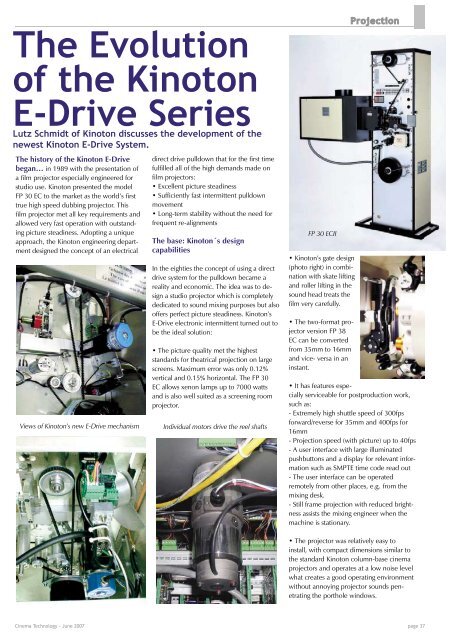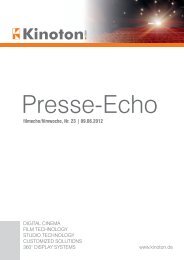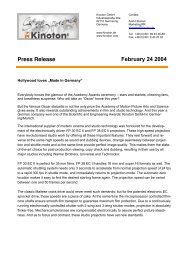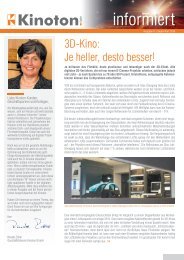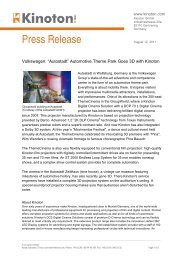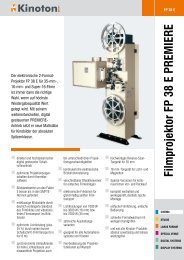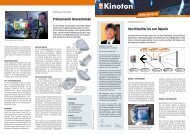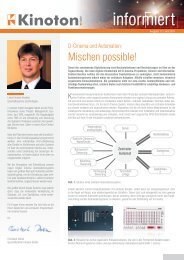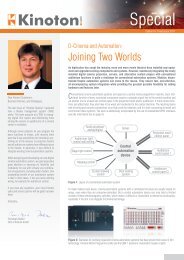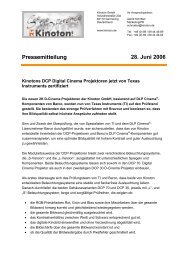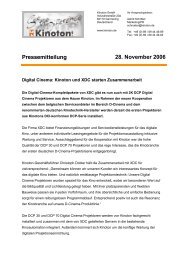The Evolution of the Kinoton E-Drive Series
The Evolution of the Kinoton E-Drive Series
The Evolution of the Kinoton E-Drive Series
Create successful ePaper yourself
Turn your PDF publications into a flip-book with our unique Google optimized e-Paper software.
<strong>The</strong> <strong>Evolution</strong><br />
<strong>of</strong> <strong>the</strong> <strong>Kinoton</strong><br />
E-<strong>Drive</strong> <strong>Series</strong><br />
Lutz Schmidt <strong>of</strong> <strong>Kinoton</strong> discusses <strong>the</strong> development <strong>of</strong> <strong>the</strong><br />
newest <strong>Kinoton</strong> E-<strong>Drive</strong> System.<br />
<strong>The</strong> history <strong>of</strong> <strong>the</strong> <strong>Kinoton</strong> E-<strong>Drive</strong><br />
began… in 1989 with <strong>the</strong> presentation <strong>of</strong><br />
a film projector especially engineered for<br />
studio use. <strong>Kinoton</strong> presented <strong>the</strong> model<br />
FP 30 EC to <strong>the</strong> market as <strong>the</strong> world’s first<br />
true high speed dubbing projector. This<br />
film projector met all key requirements and<br />
allowed very fast operation with outstanding<br />
picture steadiness. Adopting a unique<br />
approach, <strong>the</strong> <strong>Kinoton</strong> engineering department<br />
designed <strong>the</strong> concept <strong>of</strong> an electrical<br />
Views <strong>of</strong> <strong>Kinoton</strong>’s new E-<strong>Drive</strong> mechanism<br />
direct drive pulldown that for <strong>the</strong> first time<br />
fulfilled all <strong>of</strong> <strong>the</strong> high demands made on<br />
film projectors:<br />
• Excellent picture steadiness<br />
• Sufficiently fast intermittent pulldown<br />
movement<br />
• Long-term stability without <strong>the</strong> need for<br />
frequent re-alignments<br />
<strong>The</strong> base: <strong>Kinoton</strong>´s design<br />
capabilities<br />
In <strong>the</strong> eighties <strong>the</strong> concept <strong>of</strong> using a direct<br />
drive system for <strong>the</strong> pulldown became a<br />
reality and economic. <strong>The</strong> idea was to design<br />
a studio projector which is completely<br />
dedicated to sound mixing purposes but also<br />
<strong>of</strong>fers perfect picture steadiness. <strong>Kinoton</strong>’s<br />
E-<strong>Drive</strong> electronic intermittent turned out to<br />
be <strong>the</strong> ideal solution:<br />
• <strong>The</strong> picture quality met <strong>the</strong> highest<br />
standards for <strong>the</strong>atrical projection on large<br />
screens. Maximum error was only 0.12%<br />
vertical and 0.15% horizontal. <strong>The</strong> FP 30<br />
EC allows xenon lamps up to 7000 watts<br />
and is also well suited as a screening room<br />
projector.<br />
Individual motors drive <strong>the</strong> reel shafts<br />
FP 30 ECII<br />
• <strong>Kinoton</strong>’s gate design<br />
(photo right) in combination<br />
with skate lifting<br />
and roller lifting in <strong>the</strong><br />
sound head treats <strong>the</strong><br />
film very carefully.<br />
• <strong>The</strong> two-format projector<br />
version FP 38<br />
EC can be converted<br />
from 35mm to 16mm<br />
and vice- versa in an<br />
instant.<br />
Projection<br />
• It has features especially<br />
serviceable for postproduction work,<br />
such as:<br />
- Extremely high shuttle speed <strong>of</strong> 300fps<br />
forward/reverse for 35mm and 400fps for<br />
16mm<br />
- Projection speed (with picture) up to 40fps<br />
- A user interface with large illuminated<br />
pushbuttons and a display for relevant information<br />
such as SMPTE time code read out<br />
- <strong>The</strong> user interface can be operated<br />
remotely from o<strong>the</strong>r places, e.g. from <strong>the</strong><br />
mixing desk.<br />
- Still frame projection with reduced brightness<br />
assists <strong>the</strong> mixing engineer when <strong>the</strong><br />
machine is stationary.<br />
• <strong>The</strong> projector was relatively easy to<br />
install, with compact dimensions similar to<br />
<strong>the</strong> standard <strong>Kinoton</strong> column-base cinema<br />
projectors and operates at a low noise level<br />
what creates a good operating environment<br />
without annoying projector sounds penetrating<br />
<strong>the</strong> porthole windows.<br />
Cinema Technology - June 2007 page 37
page 38<br />
Projection<br />
Well accepted by <strong>the</strong> market<br />
<strong>The</strong> EC projector series proved to be a<br />
market success. <strong>The</strong> first FP 30 EC was<br />
delivered to a studio in Paris. Just one year<br />
later, ano<strong>the</strong>r EC was installed in Hollywood<br />
at <strong>the</strong> Warner studios in Burbank. After this,<br />
<strong>the</strong> number <strong>of</strong> installations kept increasing<br />
constantly.<br />
In late 1999 <strong>the</strong> follow-up models FP 30 EC<br />
II and FP 38 EC II were brought to <strong>the</strong> market.<br />
<strong>The</strong>re were no significant changes in <strong>the</strong><br />
overall projector concept but a new, even<br />
more precise intermittent drive replaced <strong>the</strong><br />
original system and several new functions<br />
were added. <strong>The</strong> new system <strong>of</strong>fers a doubled<br />
positioning resolution and it allows for<br />
compensation <strong>of</strong> small mechanical errors by<br />
electronically applying <strong>the</strong> same error in <strong>the</strong><br />
opposite direction, thus cancelling <strong>the</strong> error.<br />
<strong>The</strong> EC II projectors quickly became an industry<br />
reference for a projected 35mm (and<br />
16mm) motion picture film. For example, a<br />
world-leading manufacturer <strong>of</strong> raw film stock<br />
uses this <strong>Kinoton</strong> projection technology to<br />
project not images but perforation holes for<br />
quality checking.<br />
Since <strong>the</strong> introduction <strong>of</strong> <strong>the</strong> EC projector<br />
<strong>the</strong> studios’ demands have changed. Formerly<br />
<strong>the</strong> main focus had been on dubbing; now<br />
reference projection for colour timing, grading<br />
and checking takes centre stage, especially<br />
when digital intermediates are transferred<br />
back to film. <strong>The</strong>se applications call for split<br />
screen projection, which requires better<br />
synchronisation than <strong>the</strong> standard biphase<br />
synchronisation, so <strong>Kinoton</strong> added an option<br />
for SONY 9-pin operation. <strong>The</strong> projector<br />
synchronises on a user-selected video clock<br />
signal and follows a set <strong>of</strong> commands<br />
appropriate for a film projector (but <strong>the</strong>re is<br />
FP 30 ECII Reference <strong>Drive</strong> Electronics<br />
no ‘record’ command, <strong>of</strong> course). In cases<br />
where no edit controller or <strong>the</strong> like is used,<br />
<strong>Kinoton</strong> can supply <strong>the</strong>ir own PC based user<br />
interface.<br />
In 1998, <strong>Kinoton</strong> launched <strong>the</strong> FP 30 E-S<br />
(35mm) and FP 38 E-S (35 mm and 16mm)<br />
screening room projectors <strong>of</strong>fering various<br />
useful studio functions. <strong>The</strong>se projectors are<br />
available with a turret and can be fully automated.<br />
Ano<strong>the</strong>r feature <strong>of</strong> <strong>the</strong>se projectors<br />
is <strong>the</strong> Variodrive shutter. As a separate motor<br />
drives <strong>the</strong> shutter, this <strong>of</strong>fers several interesting<br />
features:<br />
• At low projection speeds, <strong>the</strong> shutter keeps<br />
turning at higher speeds, giving a flickerless<br />
picture which is ideal for silent film projection.<br />
Loss <strong>of</strong> light, a typical problem <strong>of</strong> mechanical<br />
3-blade shutters, is eliminated with<br />
<strong>the</strong> Variodrive shutter.<br />
• If three-blade mode is desired at 24fps,<br />
as it is common in US postproduction<br />
facilities, <strong>the</strong> 2-wing shutter is switched to<br />
a 1.5 times higher speed, having <strong>the</strong> same<br />
effect as a 3-blade shutter.<br />
<strong>The</strong> E-S projectors became very popular for<br />
screenings rooms, for print checking, and<br />
in situations with limited budgets, but also<br />
for high-class cinema applications requiring<br />
special functions. <strong>The</strong> American Film Institute<br />
AFI and <strong>the</strong> new Museum <strong>of</strong> Modern Arts in<br />
New York City, for example, both acquired<br />
FP 38 E-S film projectors, a two-format version<br />
<strong>of</strong> <strong>the</strong> FP 30 E-S suitable for 35mm and<br />
16mm films. It <strong>of</strong>fers <strong>the</strong> same studio functions<br />
listed above, such as shuttle operation<br />
and variable speed. Later additions to <strong>the</strong><br />
studio line were <strong>the</strong> FP30 E-Q and FP38 E-Q<br />
film projectors designed for postproduction<br />
facilities and laboratories, <strong>of</strong>fering still frame<br />
projection and optional Sony 9-pin interfacing<br />
for e.g. side-by-side projection<br />
film/digital.<br />
<strong>The</strong> E-<strong>Drive</strong>’s way to <strong>the</strong> cinemas<br />
Since 1997 <strong>the</strong> E-<strong>Drive</strong> has been available<br />
for ‘normal’ cinema projection as well. <strong>The</strong><br />
FP 30 E or FP 50 E film projectors <strong>of</strong>fer an<br />
image steadiness outperforming even <strong>the</strong><br />
premium <strong>Kinoton</strong> Geneva intermittents.<br />
Suitable for multi-format projection<br />
<strong>The</strong> E-<strong>Drive</strong> <strong>of</strong>fers <strong>the</strong> technical base for<br />
70mm and 16mm projection as well, as it<br />
supports different pulldown movements.<br />
Whilst <strong>the</strong> intermittent sprocket rotates 90<br />
degrees for each 35mm image, 16mm film<br />
only requires a 45 degree rotation. <strong>The</strong> E-<br />
<strong>Drive</strong> can perform both angles. For Special<br />
Venue or Large Format applications, o<strong>the</strong>r<br />
FP 38 EC<br />
different pulldown modes have been developed.<br />
E-<strong>Drive</strong> <strong>Evolution</strong><br />
This year <strong>Kinoton</strong> have launched <strong>the</strong>ir advanced<br />
E-<strong>Drive</strong> generation. <strong>The</strong> new generation<br />
E-<strong>Drive</strong> <strong>of</strong>fers significant improvements<br />
to its predecessors:<br />
• A faster film pulldown <strong>of</strong>fers a light output<br />
increase <strong>of</strong> 20% and more.<br />
• <strong>The</strong> improved positioning accuracy reduces<br />
picture jump to a virtually non-measurable<br />
value.<br />
• An extremely smooth film transport eliminates<br />
any minor vibration effects and ensures<br />
very gentle film handling.<br />
With <strong>the</strong>se improvements, a full resolution<br />
<strong>of</strong> 80 line pairs can be reached with a very<br />
good lens and film images with a suitable<br />
high image quality. If we compare this resolution<br />
in D-Cinema terms, it is an equivalent<br />
image resolution <strong>of</strong> about 3.4K, with still<br />
higher resolution produced at a lower image<br />
modulation. In addition, <strong>the</strong> high light<br />
efficiency will <strong>of</strong>ten allow a smaller xenon<br />
bulb to be used, reducing heat emission and<br />
saving energy costs.<br />
<strong>The</strong> new drive system was made available as<br />
an earlier version for a number <strong>of</strong> studio<br />
installations as <strong>the</strong> FP 30 EC II REFERENCE.<br />
By now, all <strong>Kinoton</strong> studio film projectors<br />
are delivered with <strong>the</strong> new “REFERENCE”<br />
E-<strong>Drive</strong>. And all E-type cinema film projectors<br />
like <strong>the</strong> FP 30 E or FP 50 E are equipped<br />
with <strong>the</strong> new drive system as “PREMIERE”<br />
versions.<br />
Cinema Technology - June 2007


